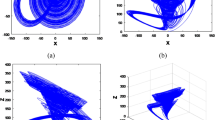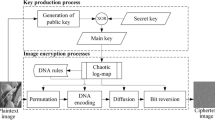Abstract
An Image Encryption Algorithm with the Quantum logistic and lorenz Chaotic map, and DNA Coding (IEA-QCDC) was proposed. Relying on some empirical analyzes and experimental results, the designers of IEA-QCDC claimed that this strategy can led to a significant enhancement in reliability and security. However, we investigate the essential properties of IEA-QCDC, and then propose an efficient chosen-plaintext attack to crack its equivalent permutation and diffusion key. By analyzing the encryption effect of continuous DNA encryption operations, the mathematical properties of some DNA codes were summarized. In addition, we find out that the iterative sequence obtained by the non-chaotic state is not even resistant to only-ciphertext attacks by analyzing the Lyapunov exponent and bifurcation diagrams of the quantum Logistic map. Aiming at the security vulnerabilities existing in IEA-QCDC, suggestions are put forward to improve the security and practicability of encryption algorithms, which will promote the development of cryptographic design to a certain extent.









Similar content being viewed by others
Data Availability
All data generated or analysed during this study are included in this published article.
References
Akhavan A, Samsudin A, Akhshani A (2017) Cryptanalysis of an image encryption algorithm based on dna encoding. Optics Laser Technol 95:94–99
Alawida M, Teh JS, Samsudin A (2019) An image encryption scheme based on hybridizing digital chaos and finite state machine. Signal Process 164:249–266
Chai X, Fu X, Gan Z, Lu Y, Chen Y (2019) A color image cryptosystem based on dynamic DNA encryption and chaos. Signal Process 155:44–62
Chen J, Chen L, Zhou Y (2020) Cryptanalysis of a dna-based image encryption scheme. Inf Sci 520:130–141
Chen J, Zhu Z, Zhang L, Zhang Y, Yang BQ (2018) Exploiting self-adaptive permutation–diffusion and DNA random encoding for secure and efficient image encryption[J]. Signal Process 142:340–353
Cheng G, Wang C, Xu C (2020) A novel hyper-chaotic image encryption scheme based on quantum genetic algorithm and compressive sensing[J]. Multimed Tools Appl 79(39):29243–29263
Dou Y, Liu X, Fan H, Li M (2017) Cryptanalysis of a dna and chaos based image encryption algorithm. Optik 145:456–464
Farah MA, Farah A, Farah T (2020) An image encryption scheme based on a new hybrid chaotic map and optimized substitution box. Nonlinear Dynam 99(4):3041–3064
Feng W, He YG (2018) Cryptanalysis and improvement of the hyper-chaotic image encryption scheme based on dna encoding and scrambling. IEEE Photonics J 10(6):1–15
Hassan BA (2021) CSCF: a chaotic sine cosine firefly algorithm for practical application problems. Neural Comput Appl 33:7011–7030
Jain K, Aji A, Krishnan P (2021) Medical image encryption scheme using multiple chaotic maps. Pattern Recogn Lett 152:356–364
Khan M, Masood F (2019) A novel chaotic image encryption technique based on multiple discrete dynamical maps. Multimed Tools Appl 78 (18):26203–26222
Lenstra AK, Verheul ER (2001) Selecting cryptographic key sizes [J]. J Crypto 14(4):255–293
Li C, Lo KT (2011) Optimal quantitative cryptanalysis of permutation-only multimedia ciphers against plaintext attacks. Signal Process 91(4):949–954
Lin H, Wang C, Cui L, Sun Y, Zhang X, Yao W (2022) Hyperchaotic memristive ring neural network and application in medical image encryption[J]. Nonlinear Dynam 110(1):841–855
Liu S, Li C, Hu Q (2021) Cryptanalyzing two image encryption algorithmsbased on a first-order time-delay system. IEEE MultiMed 29(1):74–84
Luo Y, Yu J, Lai W, Liu L (2019) A novel chaotic image encryption algorithm based on improved baker map and logistic map. Multimed Tools Appl 78(15):22023–22043
Ma Y, Li C, Ou B (2020) Cryptanalysis of an image block encryption algorithm based on chaotic maps. J Inf Security Appl 54:102566
O’Connor L (1993) On the distribution of characteristics in bijective mappings[C]. Workshop on the theory and application of cryptographic techniques. Springer, Berlin, Heidelberg, pp 360–370
Pareek NK, Patidar V, Sud KK (2006) Image encryption using chaotic logistic map. Image Vis Comput 24(9):926–934
Qader SM, Hassan BA, Rashid TA (2022) An improved deep convolutional neural network by using hybrid optimization algorithms to detect and classify brain tumor using augmented MRI images. Multimed Tools Appl 81:44059–44086
Signing VF, Tegue GG, Kountchou M, Njitacke Z, Tsafack N, Nkapkop J, Etoundi CL, Kengne J (2022) A cryptosystem based on a chameleon chaotic system and dynamic dna coding. Chaos Solitons Fractals 155:111777
Su X, Li W, Hu H (2017) Cryptanalysis of a chaos-based image encryption scheme combining DNA coding and entropy[J]. Multimed Tools Appl 76 (12):14021–14033
Sun S (2018) A novel hyperchaotic image encryption scheme based on dna encoding, pixel-level scrambling and bit-level scrambling. IEEE Photonics J 10 (2):1–14
Talhaoui MZ, Wang X (2021) A new fractional one dimensional chaotic map and its application in high-speed image encryption. Inf Sci 550:13–269
Wang X, Chen S, Zhang Y (2021) A chaotic image encryption algorithm based on random dynamic mixing. Optics Laser Technol 138:106837
Wang S, Peng Q, Du B (2022) Chaotic color image encryption based on 4D chaotic maps and DNA sequence. Optics Laser Technol 148:107753
Wang Q, Yu S, Guyeux C, Wang W (2021) Constructing higher-dimensional digital chaotic systems via loop-state contraction algorithm. IEEE Trans Circuits Syst I Regular Papers 68(9):3794–3807
Wen H, Yu S, Lü J (2019) Breaking an image encryption algorithm based on dna encoding and spatiotemporal chaos. Entropy 21(3):246
Wu J, Liao X, Yang B (2018) Image encryption using 2d h\(^{\prime }\)enon-sine map and dna approach. Signal Process 153:11–23
Xian Y, Wang X, Yan X, Li Q, Wang X (2020) Image encryption based on chaotic Sub-Block scrambling and chaotic digit selection diffusion. Opt Lasers Eng 134:106202
Xuejing K, Zihui G (2020) A new color image encryption scheme based on dna encoding and spatiotemporal chaotic system. Signal Process Image Commun 80:115670
Zhang J, Huo D (2019) Image encryption algorithm based on quantum chaotic map and dna coding. Multimed Tools Appl 78(11):15605–15621
Zhang Z, Yu S (2019) On the security of a Latin-bit cube-based image chaotic encryption algorithm. Entropy 21(9):888
Zhao D, Liu L, Yu F, Heidari AA, Wang M, Liang G, Chen H (2021) Chaotic random spare ant colony optimization for multi-threshold image segmentation of 2D Kapur entropy. Knowl-Based Syst 216:106510
Funding
This work was supported by the National Natural Science Foundation of China (No. 62271157), the Natural Science Foundation of Guangdong Province (No. 2022A1515010005).
Author information
Authors and Affiliations
Corresponding author
Ethics declarations
Conflict of Interests
The authors declare that there is no conflict of interest.
Additional information
Publisher’s note
Springer Nature remains neutral with regard to jurisdictional claims in published maps and institutional affiliations.
Simin Yu, Qianxue Wang, Christophe Guyeux and Mengjie Wang are contributed equally to this work.
Rights and permissions
Springer Nature or its licensor (e.g. a society or other partner) holds exclusive rights to this article under a publishing agreement with the author(s) or other rightsholder(s); author self-archiving of the accepted manuscript version of this article is solely governed by the terms of such publishing agreement and applicable law.
About this article
Cite this article
Chen, X., Yu, S., Wang, Q. et al. On the cryptanalysis of an image encryption algorithm with quantum chaotic map and DNA coding. Multimed Tools Appl 82, 42717–42737 (2023). https://doi.org/10.1007/s11042-023-15003-x
Received:
Revised:
Accepted:
Published:
Issue Date:
DOI: https://doi.org/10.1007/s11042-023-15003-x




